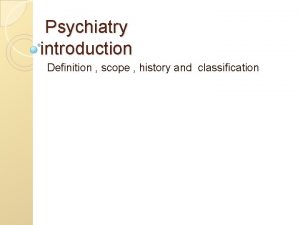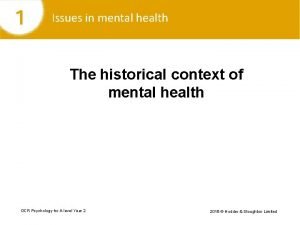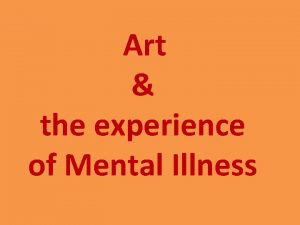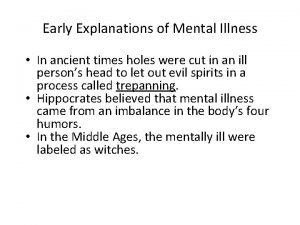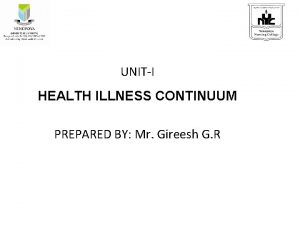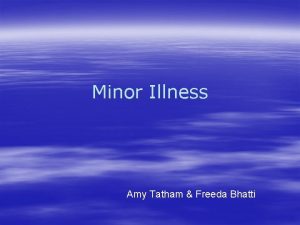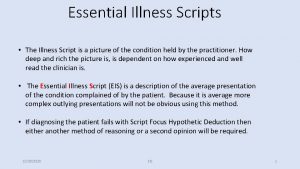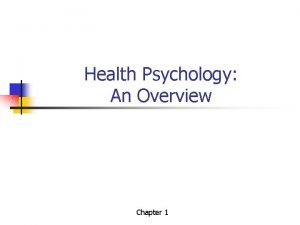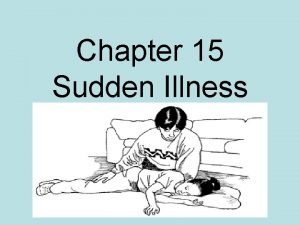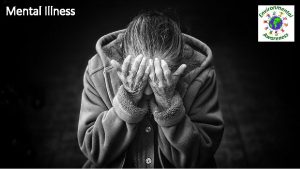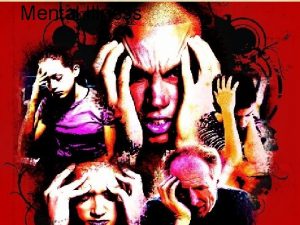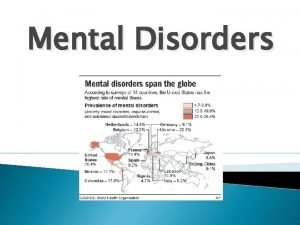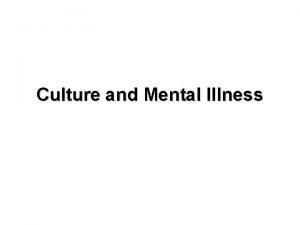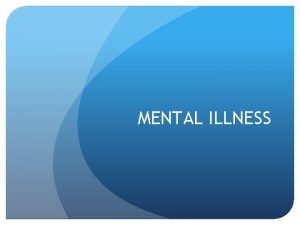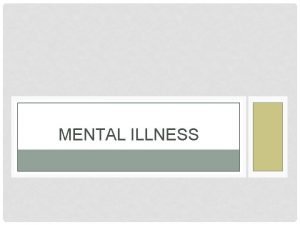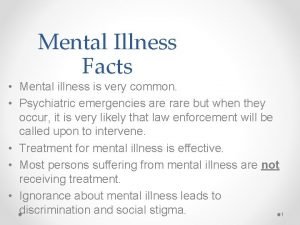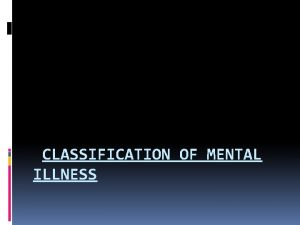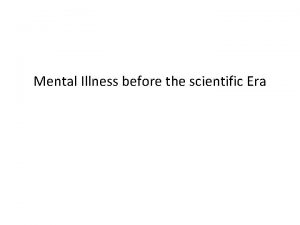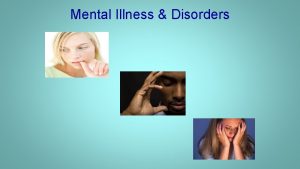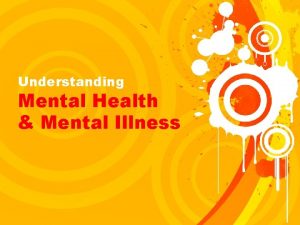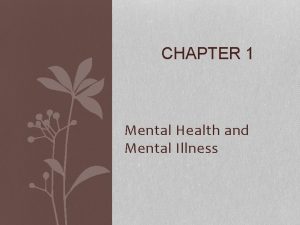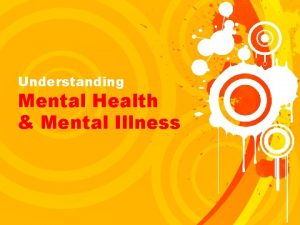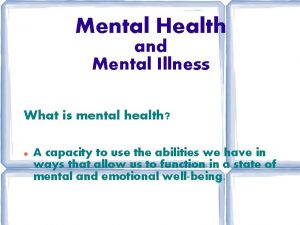Sociology of mental illness Week 22 Sociology of























- Slides: 23

Sociology of mental illness Week 22 Sociology of Health and Illness

Recap • Thought about how health and illness are structured by society • Considered the ‘sick role’, medicalisation, surveillance medicine and ‘lay’ understandings of health • Considered social inequalities and health • The impact of chronic illness and disability

Outline • Look at mental health and illness as social categories • Consider to what extent ‘diagnosis’ is linked to normative ideas • Look at the anti-psychiatry movement

What is mental illness? • What does the term mental illness mean to you?

Popular conceptions of mental illness • Often the vision we have of mental illness is linked to ideas of: – Hallucinations – Delusions – Threatening and/or disturbed behaviour – Acute withdrawal or anxiousness – Drug and/or alcohol dependency

Defining mental illness • The diagnosis of mental illness is not always straightforward • Identification of people who are finding difficulty with ‘normal’ expectations • Sociology of mental health looks at the ways in which categories come into existence, who gets diagnosed and how they are treated

Normative expectations? • What sort of behaviours count? • How are they linked to ideas current in wider society – Drapetomania – Homosexuality – Epilepsy – Sexual promiscuity

• What do you think about these historical categories of mental illness? • Do you think it is possible that behaviour which we define as mental illness will be seen in future as ‘wrong’?

Gender and mental health • Statistics show that the diagnosis of mental disorders is gendered • Women are more likely to be diagnosed as having depression, anxiety or somatic complaints. • Men are more likely to be diagnosed with antisocial personality disorder or be alcohol dependant • Risk factors for mental illness are gendered • For women: violence, socioeconomic disadvantage, subordinate social status and unremitting responsibility for the care of others have all been highlight

Feminist theories of mental health • Feminism has understood mental illness as: – a consequence of social oppression – a social construct • Both consider it as an outcome of social processes

Consequences of social oppression? • Social & economic circumstances associated with onset of depression in women. – Long term implications of life events? – Low self-esteem/inability to cope interacts with life events to produce depression. • Working class women at greatest risk.

Consequences of social oppression? • Post-Traumatic Stress Disorder is more common in women that men – Linked to high levels of sexual violence – DSM IV names ‘rape’ as a possible trigger for PTSD but not domestic violence – Women with PTSD reported have a greater symptom burden and longer course of illness

Mental illness as social construct • Studies have point out how frustration, unhappiness or rebellion labelled as mental illness in women. • Women who fail to comply with normative prescriptions of typical feminine behaviour judged as mentally ill.

Judged on femininity ‘Care with make-up and hair style were seen to be clear indications of getting better, likewise wanting marriage and children were viewed by some as part of recovery. I know of individuals who have been told that their problem would get easier if they acquired a boyfriend’ • In Foster, Women and the Health Care Industry

• To what extent do you think that normative ideas about feminine behaviour impact of the diagnosis and treatment of mental illness?

Racism and mental health • Statistics show that the diagnosis of mental disorders is related to ethnicity – Asian women high rates of depression and suicide – Black men higher rates of schizophrenia • Risk factors for mental illness have been related to racism – Socioeconomic disadvantage, subordinate social status and stereotyping

Racism and mental health • Institutional racism has been diagnosed within mental health care • Mental health outcomes for Black patients are shown to be poorer • Black groups are more likely than white people to go into specialist mental health care by coercion

David ‘Rocky’ Bennett • An African-Caribbean man who was eventually diagnosed with schizophrenia. – He made reports of being harassed and bullied by other patients – He was over-medicated (causing low blood pressure) particularly as he was seen as a nuisance – His cultural, racial, social needs were ignored – No attempt was made to engage his family in his care and treatment. – After a incident started by another patient he was restrained, collapsed and died

Treatment by psychiatric services • Independent Inquiry into death of David Bennett found institution racism • Census of inpatients in 2005: – 9% of in-patients were Black or mixed black-white ethnicity (3% of national pop) – Black patients were 44% more likely to have been sectioned & 50% more likely to have been put in seclusion – Black Caribbean men were 29% more likely to have been subject to control and restraint.

• How important do you think racism is in explaining the rates, diagnosis and treatment of mental illness in minorityethnic people?

Anti-psychiatry movement • The Anti-psychiatry has a long history. • It highlights psychiatry as using medical tools for social conditions • It focuses on coercion and the targeting of marginalised populations • Became prominent in the 1960 s and 1970 s and today often focuses on the role of pharmaceutical companies

Anti-psychiatry movement R. D. Laing • Schizophrenia as understandable reaction to conflicts between family and self or through trauma. Thomas Szasz • • Mental illness a ‘metaphor’ Label for deviation from social norms ‘Problems’ cause by rigid society Psychiatry as a tool of social and political control.

Summary • Consider how mental health and illness and closely linked to social categories • Considered gender and racism in diagnosis and treatment • Look at the opposition in the antipsychiatry movement
 Chapter 20 mental health and mental illness
Chapter 20 mental health and mental illness Mental health jeopardy game
Mental health jeopardy game Axis 1 and axis 2 disorders
Axis 1 and axis 2 disorders Classification of mental illness
Classification of mental illness Historical views of mental illness psychology ocr
Historical views of mental illness psychology ocr Mark rothko mental illness
Mark rothko mental illness Ksi mental illness
Ksi mental illness Fair housing act mental illness
Fair housing act mental illness Catherine earnshaw mental illness
Catherine earnshaw mental illness Mental illness in ancient times
Mental illness in ancient times Americanization of mental illness
Americanization of mental illness Week by week plans for documenting children's development
Week by week plans for documenting children's development Health illness continuum
Health illness continuum Minor illness definition
Minor illness definition Mike mazzalongo illness
Mike mazzalongo illness Foodborne illness
Foodborne illness Illness scripts
Illness scripts Ning li cause of death
Ning li cause of death Non thyroidal illness
Non thyroidal illness Illness and wellness continuum
Illness and wellness continuum Signs and symptoms of sudden illness
Signs and symptoms of sudden illness Continuum of health
Continuum of health Illness script
Illness script Present illness example
Present illness example



